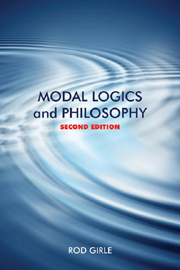Book contents
- Frontmatter
- Contents
- Preface
- Acknowledgements
- 1 Argument and modality
- Part 1 Formal systems
- 2 A simple modal logic
- 3 The normal modal logics
- 4 The non-normal modal logics
- 5 Natural deduction and axiomatics
- 6 Conditional logic
- 7 Modal predicate logics
- 8 Quantifiers and existence
- Part 2 Applications
- Answers
- Index
2 - A simple modal logic
from Part 1 - Formal systems
- Frontmatter
- Contents
- Preface
- Acknowledgements
- 1 Argument and modality
- Part 1 Formal systems
- 2 A simple modal logic
- 3 The normal modal logics
- 4 The non-normal modal logics
- 5 Natural deduction and axiomatics
- 6 Conditional logic
- 7 Modal predicate logics
- 8 Quantifiers and existence
- Part 2 Applications
- Answers
- Index
Summary
Introduction
In this chapter we set out a propositional modal logic. The logic is known as S5. It was given its name by one of the most important modal logicians of the early twentieth century; C. I. Lewis (1883–1964). Lewis constructed five axiomatic systems of modal logic and named them S1 to S5 (System 1 to System 5). It turns out that the simplest of the logics based on possible worlds is the same as Lewis's S5.
In this chapter I set out S5 in terms of modal truth trees, or modal semantic tableaux. The trees for S5 make the simplest possible use of the idea of possible worlds. I will not set out S5 in axiomatic form in this chapter, but will look at an axiomatic formulation in a later chapter.
S5 is often seen as a system capturing the idea of logical possibility. The diamond and box symbols can be used to translate as follows:
◊p = It is logically possible that p
Possibly p
It might be the case that p
☐p = It is logically necessary that p
Necessarily p
It must be the case that p
This supposition, that S5 sets out the logic of the notions of logical possibility and logical necessity, while intuitively reasonable, is not without difficulties and is discussed in Chapter 9.
Propositional modal logic
I begin with propositional modal logic.
- Type
- Chapter
- Information
- Modal Logics and Philosophy , pp. 13 - 27Publisher: Acumen PublishingPrint publication year: 2009



